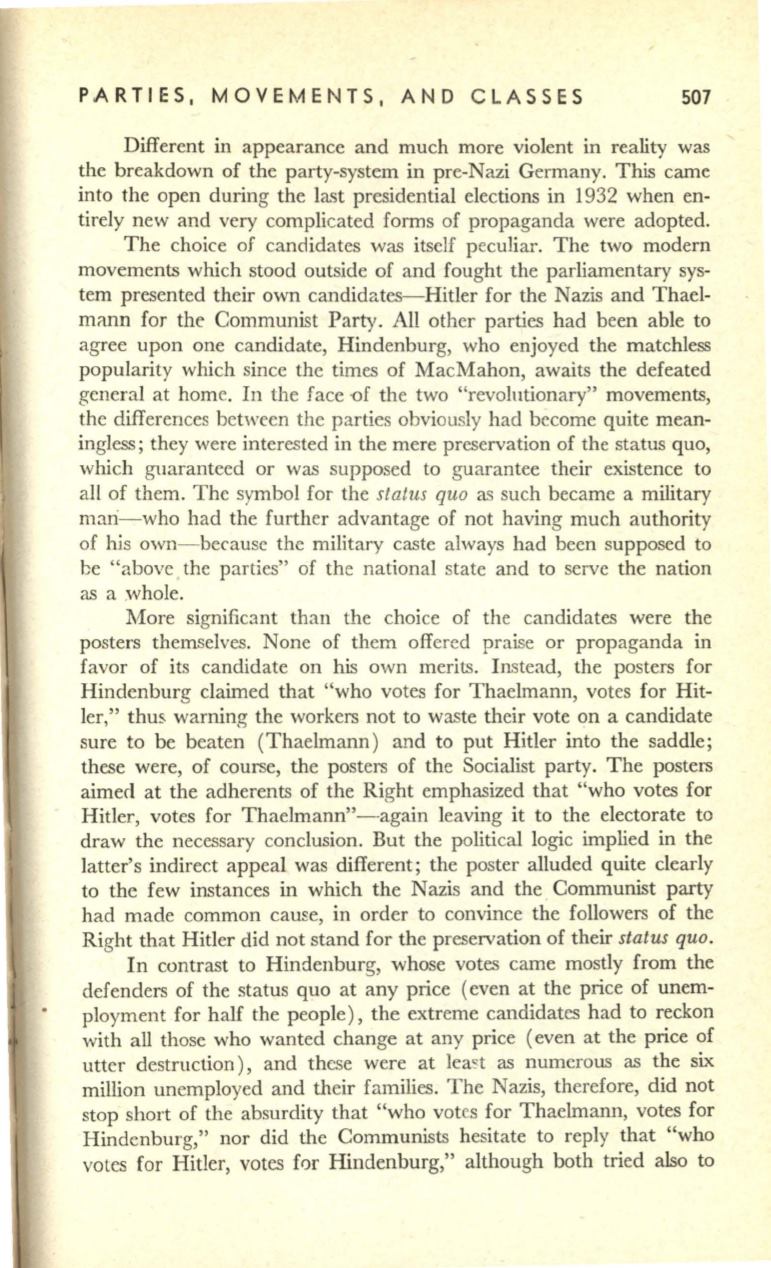
PARTIES, MOVEMENTS, AND CLASSES
507
Different in appearance and much more violent in reality was
the breakdown of the party-system in pre-Nazi Germany. This came
into the open during the last presidential elections in 1932 when en–
tirely new and very complicated forms of propaganda were adopted.
The choice of candidates was itself peculiar. The two modern
movements which stood outside of and fought the parliamentary sys–
tem presented their own candidates-Hitler for the Nazis and Thad–
mann for the Communist Party. All other parties had been able to
agree upon one candidate, Hindenburg, who enjoyed the matchless
popularity which since the times of MacMahon, awaits the defeated
general at home. In the face -of the two "revolutionary" movements,
the differences between the parties obviously had become quite mean–
ingless; they were interested in the mere preservation of the status quo,
which guaranteed or was supposed to guarantee their existence to
all of them. The symbol for the
status quo
as such became a military
mari- who had the further advantage of not having much authority
of his own-because the military caste always had been supposed to
be "above the parties" of the national state and to serve the nation
as a .whole.
More significant than the choice of the candidates were the
posters themselves. None of them offered praise or propaganda in
favor of its candidate on his own merits. Instead, the posters for
Hindenburg claimed that "who votes for Thaelmann, votes for Hit–
ler," thus warning the workers not to waste their vote on a candidate
sure to be beaten (Thaelmann) and to put Hitler into the saddle;
these were, of course, the posters of the Socialist party. The posters
aimed at the adherents of the Right emphasized that "who votes for
Hitler, votes for Thaelmann"-again leaving
it
to the electorate to
draw the necessary conclusion. But the political logic implied in the
latter's indirect appeal was different; the poster alluded quite clearly
to the few instances in which the Nazis and the Communist party
had made common
cau~e,
in order to convince the followers of the
Right that Hitler did not stand for the preservation of their
status quo.
In contrast to Hindenburg, whose votes came mostly from the
defenders of the status quo at any price (even at the price of unem–
ployment for half the people), the extreme candidates had to reckon
with all those who wanted change at any price (even at the price of
utter destruction), and these were at least as numerous as the six
million unemployed and their families. The Nazis, therefore, did not
stop short of the absurdity that "who votes for Thaelmann, votes for
Hindenburg," nor did the Communists hesitate to reply that "who
votes for Hitler, votes for Hindenburg," although both tried also to


